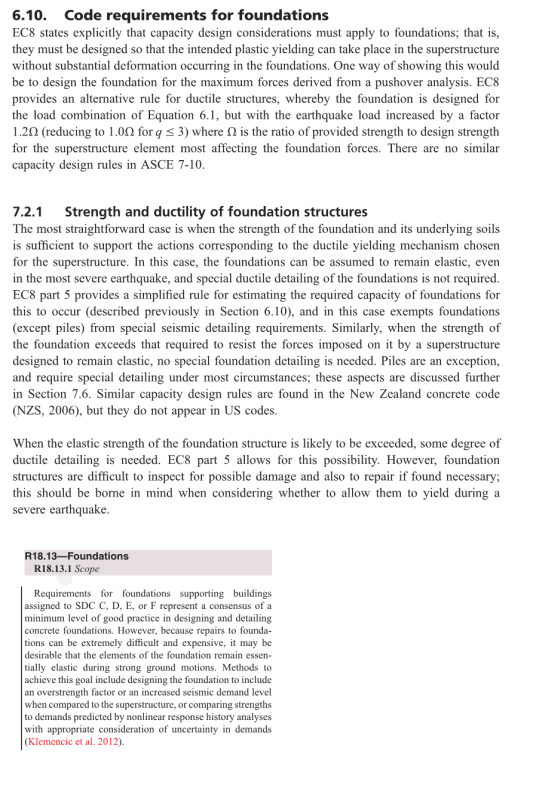li0ngalahad
Structural
- May 10, 2013
- 89
Hi, I have recently had a discussion with a colleague regarding seismic design of foundations. In his opinion foundations, like rafts supporting shear walls, should be designed with the same design loads as for the suprstructure, i.e. if I have a building with limited ductile shear walls, foundations should be designed with the same seismic loads, i.e. resuced by a factor of Sp/mu. I was arguing that unless the foundation can be idealized as a flexural member where plastic hinges can form, you cannot consider the foundation as ductile and therefore must be designed with an overstrength factor of mu/Sp. He was arguing back that if you do so, you also need to check overturning, bearing pressures with the same load and for a small building with not a great deal of gravity load on shear walls, and very high natural frequency, you would always come up with huge foundations otherwise they would alwasy overturn or reach excessive pressures. Speaking with other colleagues Id say most of them don't have a strong opinion on this (I suspect they have not much of an idea about it) but they generally seem to lean on designing foundation with threduced design loads, based on their past experience.
For me it makes sense to design the foundaiton for the un-reduced seismic loads mu=1 Sp=1, however seems to be common practice in Australia to just create a model based on a certain ductility and design everything based on the reduced design loads Sp/mu, however the more I get familiar with seismic design, the less this approach seems correct.
The code seems to be silent on this (correct me if I'm wrong). I really think the commitee members are being a bit too optimistic with the Austalian engineers comptence in regards to Seismic matters - recently speaking with some graduates, seismic is still something that is barely mentioned in the civil Engineering courses and they come out from uni not knowing a single thing on this matter.
AS1170.4 table 6.5(A) lists mu and Sp factors for a series of walls and frames structures, and then specifies that for "Other concrete structures not listed above" mu = 2 and Sp=0.77
Obvioulsy this table was superseded by table 14.3 on AS3600-2018 however there's no "Other concrete structures" in the list. There is a note however saying that "Structures and systems not covered in the above table shall have structural ductility factor (mu) and structural performance factor (Sp) determined by a rational analysis.", I cant say I understand the meaning of this phrase fully.
So my question to you is, can we design foundations for the reduced load Sp/mu? and if so, what is the logic behind this?
Thanks for you input as always.
For me it makes sense to design the foundaiton for the un-reduced seismic loads mu=1 Sp=1, however seems to be common practice in Australia to just create a model based on a certain ductility and design everything based on the reduced design loads Sp/mu, however the more I get familiar with seismic design, the less this approach seems correct.
The code seems to be silent on this (correct me if I'm wrong). I really think the commitee members are being a bit too optimistic with the Austalian engineers comptence in regards to Seismic matters - recently speaking with some graduates, seismic is still something that is barely mentioned in the civil Engineering courses and they come out from uni not knowing a single thing on this matter.
AS1170.4 table 6.5(A) lists mu and Sp factors for a series of walls and frames structures, and then specifies that for "Other concrete structures not listed above" mu = 2 and Sp=0.77
Obvioulsy this table was superseded by table 14.3 on AS3600-2018 however there's no "Other concrete structures" in the list. There is a note however saying that "Structures and systems not covered in the above table shall have structural ductility factor (mu) and structural performance factor (Sp) determined by a rational analysis.", I cant say I understand the meaning of this phrase fully.
So my question to you is, can we design foundations for the reduced load Sp/mu? and if so, what is the logic behind this?
Thanks for you input as always.



